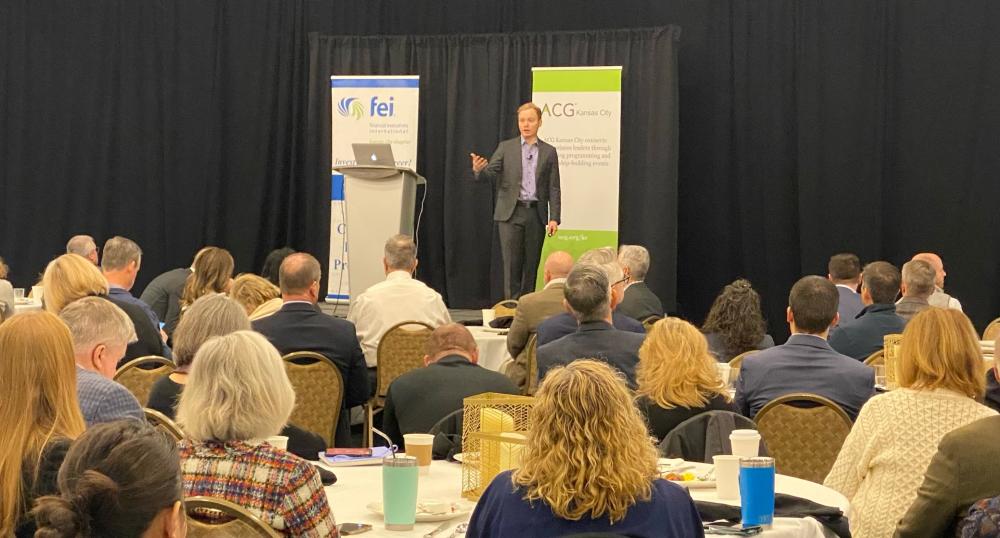

Early in his address at ACG’s monthly meeting Jan. 13, Connor Lokar reinforced the conventional wisdom: “There’s a recession coming.”
Lokar is senior forecaster for ITR Economics, based in Manchester, N.H. He described ITR as “unbiased politically” or any other way.
ITR made a GDP forecast in mid-2021, Lokar said. Eighteen months later, the actual GDP numbers deviated only 1.2% from ITR’s prediction, within the acceptable range for such a forecast.
The company did overestimate the 2022 housing market, though, which is “a biggie” as a leading, leverage-dependent sector that’s “in the toilet right now.” Housing development is down nearly 24% across the country showing—“scary numbers.” It’s down 23% in Missouri but up 4.7% in Kansas.
“Builders can’t build for $300,000 because of their rising costs,” he said.
ITR predicts housing will rebound next year and further improve in 2025.
Overall, the U.S. economy is “in the slowing growth phase of the business cycle,” though it’s still growing but at a slower rate than this time last year. U.S. industrial production grew at a 4% annual rate—“not a bad growth rate,” Lokar said. The media consensus is that it’s not if but when a recession will hit. ITR forecasts that growth will go negative in 2024 and then rebound in 2025 and 2026.
“It’s an object in the windshield that’s going to gradually get closer,” he said, and “business is very clearly slowing down.” In 2022 and 2021, there was a “massively growing pie” and business was overselling its capacity. In 2023 and 2024, that pie’s growth will slow and then start shrinking.
Zooming out for a look at the global economy, Lokar said the G7 leading indicator shows about 45% to 50% of global GDP. ITR expects that rate to fall in eight months. The G7 comprises Canada, France, Germany, Italy, Japan, the United Kingdom and the United States.
The U.S. economy holds the biggest share of the world’s $97.1 trillion GDP, at 23.7%, followed by China at 18.3%, Japan at 5.1%, Germany at 4.4%, the United Kingdom and India tied at 3.3% and France at 3%.
Lokar said the labor market, inflation and the supply chain would improve in the next 18 to 24 months. The supply chain has been improving by either plateauing or slowing lead time. People are “paying through the nose but finding what they need.” In 2023 and 2024 “the supply chain excuse should fade.” In the fall, the supply chain index, which leads the supply chain by seven months, will fall as “aggregate demand pressure” returns to the supply side in a “softening macroeconomic environment.”
“All metrics show we’re slowing down,” he said. “Our concern is more 2024 because there’s still quite a bit of excess demand in 2023.”
Still, the U.S. is “bullish by default” in the “least ugly duckling contest.” Lokar thinks India will have the world’s third-largest GDP by 2030. Russia’s economy is smaller than the economies of California and Texas.
“Russia’s overrated, basically like the Notre Dame of geopolitics,” he said. “Military is where they flex their relevance,” and the Russia-Ukraine war is driving inflation.
ITR predicts that this year’s fourth quarter and next year’s first quarter “should look pretty good.” The Federal Reserve thinks the economy will improve in 2024; ITR thinks it will worsen. The Fed is “pushing too far, too fast.” The 90-day T-bill is 120 basis points higher than the 10-year treasury yield, “a steep, deep and scary inversion in this iteration of the yield curve comparison.”
If the inversion lasts for two months, it’s a recession, Lokar said, but it takes 11 to 13 months for a recession to hit after the yield curve inverts. ITR assumes Fed hikes in February and March. If not, a downside risk will emerge for 2025.
“This matters to you,” he said. He dissuades people from thinking their local or regional markets are immune to recession. He thinks Kansas and Missouri will have a recession by the end of this year. If they manage for it this year and have a liquid position, opportunities for purchases will emerge in 2024.
“We need to prepare for this,” Lokar said.
Consumers buying goods “keeps us moving forward.” COVID-19’s onset and resulting lockdowns led to “the biggest consumer block on earth.” As fast as that happened it ended because the government “helicoptered cash” into the system.
Despite his warnings, Lokar said the “biggest thing to think about” is that “none of these data points are horrific.”
“On a 30-year time scale, we’re right where we should have been.”
During a Q&A session following Lokar’s presentation, an audience member asked how many prior recessions had been as widely anticipated as the looming one. His answer: “Probably none.”

Register by January 14 to lock in the lowest rate and join 3,200+ dealmakers in Las Vegas on April 27-29, 2026.
